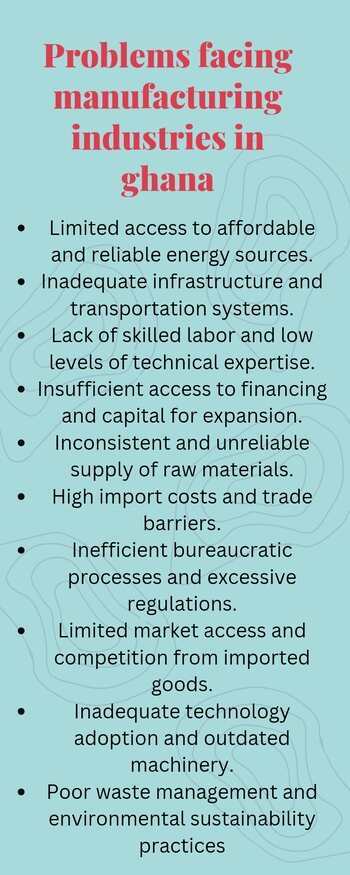Last updated on September 4th, 2023 at 01:36 am
Today, we delve into the realm of Ghana’s manufacturing industries and shed light on the various challenges they face. Ghana, a vibrant and resource-rich nation in West Africa, has made significant strides in industrialization over the years. However, like many developing countries, it encounters its fair share of hurdles on the path to sustained growth and prosperity. In this article, we’ll explore some of the key problems facing the manufacturing industries in Ghana and discuss potential solutions to address them.
Here are list of problems facing manufacturing industries in Ghana
1. Inadequate Infrastructure
One of the most pressing issues hindering the growth of manufacturing industries in Ghana is the lack of adequate infrastructure. Insufficient transportation networks, unreliable power supply, and inadequate access to water and sanitation services pose significant challenges. Without a robust infrastructure backbone, manufacturers struggle to transport raw materials, distribute finished products, and maintain uninterrupted production processes. These limitations increase costs and undermine the sector’s overall efficiency.
Also Checkout: Problems facing east African community
To overcome this challenge, the government and private sector stakeholders must prioritize infrastructure development. Investments in road networks, electricity generation and distribution, water supply systems, and digital connectivity are essential. Collaborating with international partners and leveraging public-private partnerships can help accelerate progress in infrastructure development and create a favorable environment for manufacturing industries to thrive.
2. Limited Access to Finance
Access to finance remains a significant hurdle for manufacturers in Ghana. Many small and medium-sized enterprises (SMEs) face difficulties in securing loans or investment capital to expand their operations. Banks often perceive the manufacturing sector as high risk, leading to limited credit availability and stringent borrowing conditions. This lack of financial support inhibits investment in modern technologies, hampers innovation, and restricts growth opportunities.
To alleviate this problem, it is crucial to establish specialized financing schemes and institutions tailored to the needs of manufacturing industries. Encouraging collaboration between banks and manufacturers, implementing favorable loan guarantee programs, and promoting financial literacy can facilitate improved access to finance. Additionally, fostering partnerships with international financial institutions and attracting foreign direct investment can inject much-needed capital into the sector.
3. Skills Gap and Workforce Development
Another challenge confronting manufacturing industries in Ghana is the widening skills gap and the need for workforce development. Technological advancements and evolving industry requirements demand a skilled and adaptable workforce. However, the current education and training systems often fail to produce graduates with the necessary expertise and practical skills required by the manufacturing sector.
Addressing this issue requires a multi-faceted approach. Collaboration between industries and educational institutions can help align curricula with industry needs, promoting vocational and technical training programs. Moreover, promoting apprenticeships, internships, and on-the-job training initiatives can bridge the skills gap by providing practical experience and fostering a culture of lifelong learning.
4 High Energy Costs
Manufacturers in Ghana face high energy costs, which adversely impact their competitiveness in the global market. Electricity tariffs and the unreliability of power supply put an additional burden on businesses, leading to increased production costs and reduced profitability. Energy-intensive industries, such as those involved in agro-processing or heavy manufacturing, are particularly affected.
To tackle this challenge, Ghana must prioritize the development of a diverse and sustainable energy mix. Expanding renewable energy sources, such as solar and wind, can help reduce dependence on fossil fuels and stabilize energy costs. Encouraging investment in energy-efficient technologies and promoting energy conservation practices within the manufacturing sector can also lead to significant cost savings.
Conclusion:
While the manufacturing sector in Ghana faces several challenges, there are opportunities for growth and improvement. By addressing infrastructure deficits, improving access to finance, focusing on workforce development, and tackling energy costs, Ghana can foster a conducive environment for manufacturing industries to flourish. The government, private sector, and educational institutions must collaborate to implement effective policies and initiatives to overcome these problems facing manufacturing industries in Ghana.
